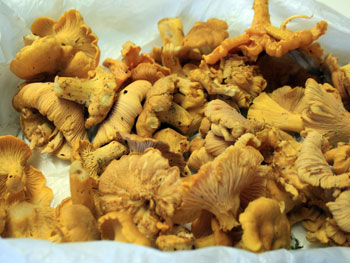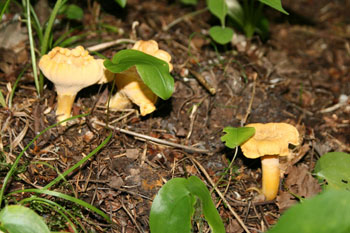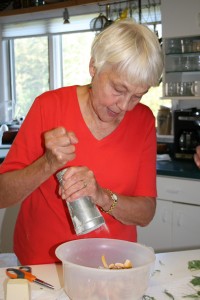 People are surprised when they discover I don’t care for mushrooms. I’ve had difficulty getting enthusiastic about the earthy-flavored fungus from the forest. I haven’t developed an appreciation for their texture that feels like rubber bands in my mouth.
People are surprised when they discover I don’t care for mushrooms. I’ve had difficulty getting enthusiastic about the earthy-flavored fungus from the forest. I haven’t developed an appreciation for their texture that feels like rubber bands in my mouth.
My repugnance toward mushrooms took a surprising turn last Friday evening when I had my first taste of freshly foraged chanterelles.
I was in Duluth for a weekend of touring urban vegetable gardens and dining on remarkable food with friends, all of us members of the Minneapolis-St. Paul chapter of Les Dames d’Escoffier International (LDEI). Les Dames, as members affectionately refer to the organization, is a world wide philanthropic society of professional women leaders in the fields of food, fine beverage and hospitality.
I was staying at the home of Beatrice and Dick Ojakangas, tucked into a wooded acreage in the countryside several miles outside the city of Duluth.
With a sparkle in his eyes and a mischievous grin on his face, Dick Ojankangas, a retired professor of geology, looked a bit like a happy gnome when he invited me out to the forest to look for chanterelle mushrooms. He handed me a bag and off we went, following the long, winding driveway.
The experienced forager knew exactly where to veer off the blacktop into the woods. With his eyes down, Ojakangas stepped carefully on the forest floor. “Look for mushrooms the color of yellow Cheddar cheese,” said Ojakangas.
 In just minutes we spotted bright chanterelles popping through the dark colored carpet of dead leaves, weeds and twigs under balsam trees.
In just minutes we spotted bright chanterelles popping through the dark colored carpet of dead leaves, weeds and twigs under balsam trees.
It’s important to know exactly what you are looking for when foraging for mushrooms that you plan to eat. Ojakangas explained the chanterelle has ridges on the underside of its cap that run smoothly into the stalk, with no defined band of a stopping point near the top of the stalk. They grow directly from the ground, not on tree trunks or logs.
I learned it’s important to harvest chanterelles by using a knife to cut the stalk near the ground. This method allows the mushrooms to grow back the following year. The Cheddar-cheese-yellow beauties had ruffled edges, sometimes curling up to form a graceful trumpet shape. They were the most beautiful mushrooms I’d ever seen.
The aroma of damp woods and pine needles was exhilarating. Each time we spotted a few more chanterelles, my heart quickened with excitement.
 The plastic bag held many bright yellow-orange mushrooms as we headed back up the driveway toward the house. The promise of a glass of Chardonnay on the deck is what kept the bounce in my step alive. After this nature-loving mushroom expert had taken time to share his passion for harvesting chanterelles with me, I worried all the way back to the house about how he would react to my bad news. How could I tell him I didn’t care to eat mushrooms?
The plastic bag held many bright yellow-orange mushrooms as we headed back up the driveway toward the house. The promise of a glass of Chardonnay on the deck is what kept the bounce in my step alive. After this nature-loving mushroom expert had taken time to share his passion for harvesting chanterelles with me, I worried all the way back to the house about how he would react to my bad news. How could I tell him I didn’t care to eat mushrooms?
Beatrice waited for us in the bright, open kitchen lined with white cupboards, white counter-tops and plenty of natural light streaming in through two walls of windows. After admiring our loot from the forest, Dick got right to work. Propped on a stool at the large island in the middle of the kitchen, he used the tip of a knife to clean out bits of dirt stuck in the ridges of the chanterelles. After a quick swish through water in a bowl and some drying time in a closed oven warmed only by its light, the gourmet mushrooms would be passed off to Beatrice for her special treatment.
Chilled Chardonnay was poured before the official hand-off to the Finnish food queen. A Minnesota native with strong roots in Finland, Beatrice Ojakangas is well-known for the many cookbooks she has authored and well-loved by all home cooks who use them. She specializes in Scandinavian cooking and baking. The experienced woman with the saute pan pounded her flour shaker with authority, sending a film of white powder over the chanterelles in a generous-sized plastic bowl.
 While butter melted in a saute pan on an induction burner situated on a nearby counter, Beatrice added ground cumin and coriander to the bowl, tossing the mushrooms to distribute the seasonings. There was not a measuring spoon in sight. Fresh sage leaves snipped from pots of herbs growing on her deck flavored the butter in the pan. The seasoned chanterelles went into the pan of sizzling butter. Once they were golden and crispy on the outside, they were ready to eat.
While butter melted in a saute pan on an induction burner situated on a nearby counter, Beatrice added ground cumin and coriander to the bowl, tossing the mushrooms to distribute the seasonings. There was not a measuring spoon in sight. Fresh sage leaves snipped from pots of herbs growing on her deck flavored the butter in the pan. The seasoned chanterelles went into the pan of sizzling butter. Once they were golden and crispy on the outside, they were ready to eat.
Chanterelles gathered and cooked with kind friends who have a passion for nature and good food is an experience that taught me how to appreciate mushrooms. Of course, the Chardonnay helped, too. My repugnance for mushrooms has turned into ravenous desire — for chanterelles.
Sue Doeden is a popular cooking instructor, food writer and integrative nutrition health coach. She is the host of Good Food, Good Life 365 on Lakeland Public Television. Her own hives full of hardworking bees and her love of honey led to the creation of her recently published cookbook, Homemade with Honey.

